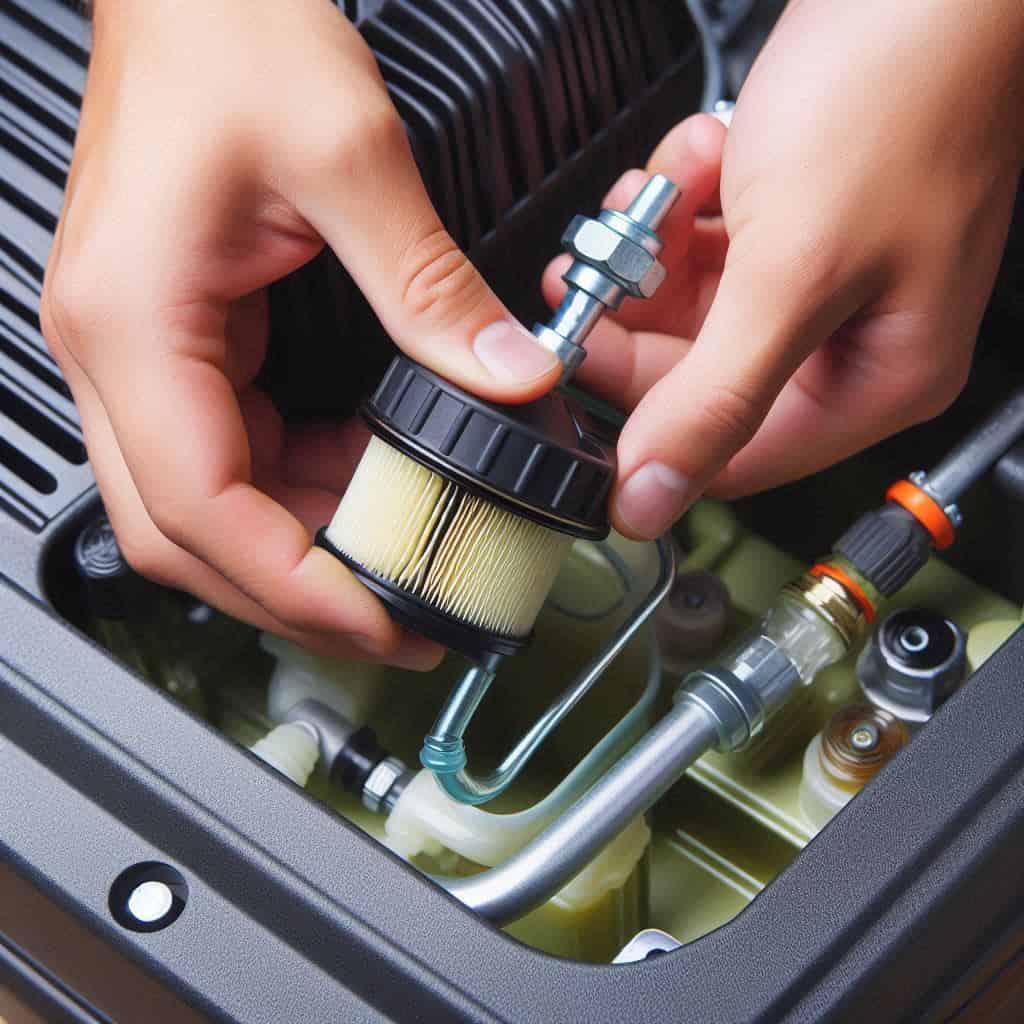Maintaining your lawn mower is crucial for keeping your yard looking its best. A well-maintained mower ensures efficient operation, a cleaner cut, and extends the lifespan of your equipment.
One often overlooked aspect of lawn mower maintenance is the fuel filter which plays an instrumental role in ensuring your lawn mower’s engine runs smoothly. It acts as a barrier, filtering out dirt, debris, and other contaminants from the fuel before it reaches the engine. This prevents clogging and potential damage to the engine components.
Without a properly functioning fuel filter, your mower might experience reduced performance or even complete failure.
Following these steps will ensure that your lawn mower runs efficiently and has a longer operational life. Do be prepared for unexpected issues that may arise with your mower while performing maintenance tasks. Sometimes a little bit of troubleshooting is all you need to get the problem fixed. E.g. the spark plug and battery might need replacement or maintenance tasks like cleaning the carburetor might be necessary.
Ready to dive into each step? Let’s get started on replacing that fuel filter!
What is a Lawn Mower Fuel Filter?
The fuel filter is an unsung hero in your lawn mower’s engine, quietly ensuring that only clean fuel reaches the engine. By filtering out dirt, debris, and other impurities, it helps maintain optimal engine performance and longevity.
What Does a Fuel Filter Do?
A fuel filter’s primary job is to protect the engine from contaminants present in the fuel. Clean fuel is essential for efficient combustion and smooth operation. When contaminants enter the fuel system, they can cause blockages and wear down engine components. Thus, the fuel filter ensures:
- Cleaner Combustion: By removing impurities, it prevents clogging and supports efficient fuel combustion.
- Extended Engine Life: Fewer contaminants mean less wear and tear on the engine.
- Reliable Performance: This keeps the engine running smoothly without interruptions.
Types of Fuel Filters
Fuel filters come in different types, primarily in-line and in-pipe, each suited to specific mower designs.
- In-Line Fuel Filters: These are installed directly in the fuel line between the tank and the carburetor. They are usually see-through, allowing for easy inspection.
- Example: A typical riding mower might use an in-line filter due to its straightforward installation.
- In-Pipe Fuel Filters: Built into the fuel pipe itself, these are generally not visible without disassembling parts of the mower. They are more common in compact or less accessible areas.
- Example: Some walk-behind mowers might have in-pipe filters integrated into their design for a sleeker look.
Why You Should Replace the Fuel Filter
- Improved Performance: A clogged fuel filter can restrict fuel flow, causing your mower to run poorly.
- Extended Engine Life: Keeping the fuel system clean helps prevent damage to internal components.
- Better Fuel Efficiency: A clean filter ensures optimal combustion, which can improve gas mileage.
When to Replace the Fuel Filter
Seasonally: It’s good practice to check and replace it at the beginning of each mowing season.
After Long Storage: If you’ve stored your mower for an extended period, inspect and possibly replace the filter before use.
Signs of Clogging:
- Difficulty starting
- Stalling during operation
- Reduced power while mowing
Symptoms of a Clogged Fuel Filter
Recognizing when your fuel filter is clogged can save you from bigger headaches down the road. Here are some common symptoms:
Engine Sputtering or Stalling:
If your engine sputters or stalls frequently, it could be due to insufficient fuel flow caused by a clogged filter. When the fuel filter is blocked, the engine doesn’t receive a steady supply of fuel, leading to intermittent power loss. This can cause the mower to sputter as if it’s running out of gas, or even stall completely during operation.
Difficulty Starting:
A clogged filter restricts fuel supply, making it hard for your mower to start. When you turn the key or pull the starter cord, the engine struggles to ignite because the necessary fuel isn’t reaching the combustion chamber. This could result in multiple attempts before the engine finally starts, if at all.
Reduced Power:
Noticeable drop in power or uneven performance often indicates a blockage. You might find that your mower lacks its usual strength when cutting grass, particularly in thicker patches. The engine may seem to run smoothly one moment and then lose power suddenly, making it difficult to maintain a consistent mowing pace.
Black Smoke from Exhaust:
Poor combustion resulting from inadequate fuel can lead to black smoke emissions. When there isn’t enough clean fuel entering the carburetor, the air-fuel mixture becomes too rich (too much fuel compared to air). This imbalance causes incomplete combustion, which manifests as black smoke coming from the exhaust pipe.
Understanding these symptoms helps you diagnose issues early, preventing prolonged damage to your mower’s engine. Replacing a clogged filter promptly ensures that your lawn mower continues to perform at its best.
Tools Required for Fuel Filter Replacement
Having the right tools at hand is important when it replacing the fuel filter on your lawn mower. Using the appropriate equipment ensures a smooth and efficient process and enhances safety.
Here’s a comprehensive list of essential tools you’ll need:
Essential Tools
- Hose Pinch-Off Pliers: These are specifically designed to clamp off the fuel line, preventing fuel from leaking out during the replacement process. They ensure that you can work without worrying about spillage.
- Regular Pliers: Useful for gripping and pulling off the old fuel filter. They come in handy for various tasks throughout the maintenance procedure.
- Screwdrivers: Depending on your mower model, you might need either a flat-head or Phillips screwdriver to access certain components.
- Utility Knife: Helpful for cutting through stubborn hoses if they’re stuck or difficult to remove from the old filter.
- Replacement Fuel Filter: Make sure you have the correct replacement part for your specific mower model. Check your mower’s manual or consult with a professional if you’re unsure.
Safety Gear
Handling lawn mower maintenance requires attention to safety. Here are some items that will help keep you protected:
- Gloves: Fuel and engine parts can be messy and potentially harmful to your skin. Wearing gloves helps protect your hands from cuts, abrasions, and exposure to fuel.
- Safety Glasses: Eye protection is important when dealing with any kind of machinery repair to prevent dust, debris, or fuel splashes from harming your eyes.
- Shop Rags: Keep a few rags handy to clean up any spills quickly. They are also useful for wiping down tools and components as you work.
Having these tools and safety gear ready before starting ensures that you can replace the fuel filter efficiently and safely. Understanding what each tool does helps create confidence as you approach this maintenance task.
Locating the Fuel Filter on Your Lawn Mower
Finding the fuel filter on your lawn mower might seem like a daunting task, but it’s simpler than you think. It varies depending on the type of mower you have, so let’s break it down step-by-step for each category.
Ride-On Mowers
- Open the hood: Lift the seat or hood to access the engine compartment.
- Locate the fuel tank: The fuel filter is usually found along the fuel line between the fuel tank and carburetor.
- Trace the fuel line: Follow the line coming out of the fuel tank; you should spot a small cylindrical component – that’s your fuel filter.
Zero Turn Mowers
- Access the engine compartment: Usually located at the rear of the mower.
- Find the fuel line: Identify where the fuel line runs from the tank to the engine.
- Spot the filter: Look for a transparent or semi-transparent part along this line – that’s your filter.
Walk-Behind Mowers
- Remove any covers: Depending on your model, you might need to remove an engine cover or tilt back a panel.
- Check near the carburetor: The fuel filter is often near or directly connected to the carburetor.
- Inspect along the fuel line: Follow the hose from your gas tank, and you’ll find a small filter typically secured with clamps.
Understanding your mower’s layout is crucial for successful maintenance tasks. Familiarize yourself with key engine components like the carburetor, fuel line clamp, and air filter to make these tasks easier in the future. If you’re unsure how to clean these parts, such as the lawn mower carburetor, there are resources available to guide you.
Keep your owner’s manual handy; it often has diagrams specific to your model which can be incredibly helpful during this process.

Step-by-Step Guide to Replace Lawn Mower Fuel Filter
1. Prepare for Replacement
Replacing a lawn mower fuel filter is a straightforward task, but preparation is essential for safety and efficiency. Following these steps ensures a smooth process without any mishaps.
Importance of Disconnecting the Spark Plug Wire(s) Before Starting Work
Safety should always be your top priority when performing any maintenance task on your lawn mower. Disconnecting the spark plug wire(s) is crucial to prevent accidental engine start-up during the replacement process. Here’s why:
- Prevents Accidental Ignition: Removing the spark plug wire stops any possibility of the engine accidentally starting while you work on it. This is crucial because even a brief, unintended ignition can lead to severe injuries or equipment damage.
- Ensures Personal Safety: Prevents any potential injuries caused by unexpected movements of the mower blades or engine parts. By disconnecting the spark plug wire, you eliminate the risk of the blades suddenly spinning, which could result in cuts or other serious injuries. Additionally, it helps avoid any sudden jerks from the engine that might cause you to lose your balance or drop tools.
To disconnect the spark plug wire:
Locate the Spark Plug:
The spark plug is a critical component of your lawn mower’s engine. You can usually find it positioned at the front or side of the engine, depending on your mower’s make and model. Look for a thick, rubber-covered wire leading to a metal tip—this is the spark plug wire connected to the spark plug.
Pull Off the Wire:
- Firmly Grasp the Rubber Boot: The rubber boot covers the end of the spark plug wire and ensures a secure connection to the spark plug. To safely disconnect it, grip this rubber boot firmly.
- Pull with Steady Force: Apply steady, even pressure as you pull the boot off. Avoid yanking or pulling at an angle, as this could damage the wire or its connection point. This action effectively disconnects the electrical current to the spark plug, ensuring there’s no risk of accidental ignition while you perform maintenance tasks.
Tips for Safely Preparing Your Mower for Maintenance
Preparation extends beyond just disconnecting the spark plug wire. Here are additional steps to ensure your mower is ready for fuel filter replacement:
- Park on a Level Surface: Ensure your lawn mower is on a flat, stable surface to prevent it from tipping over.
- Drain Excess Fuel: If possible, run your mower until it’s low on fuel to reduce spillage risks during filter replacement.
- Use Proper Lighting: Adequate lighting helps you see all components clearly and avoid mistakes.
- Wear Safety Gear: Put on gloves and eye protection to shield yourself from fuel splashes and debris.
Additionally, having shop rags handy can help manage any small spills, keeping your workspace clean and safe.
By carefully preparing your lawn mower and following these precautions, you’re setting yourself up for a successful and hassle-free fuel filter replacement. With everything in place, you can move forward confidently with changing out that old filter, ensuring your lawn mower runs smoothly all season long.
However, if you encounter other appliance issues during this process, such as with your microwave or printer, don’t hesitate to explore resources that provide step-by-step solutions for those problems as well.
2. Preventing Fuel Spillage During Replacement Process
Replacing a lawn mower fuel filter can get messy if fuel spills are not properly managed. Using hose pinch-off pliers to clamp off the fuel line is essential for a clean and safe replacement process. This small tool pinches the hose, stopping the flow of fuel and preventing unwanted spills.
Here’s a step-by-step guide to effectively use hose pinch-off pliers:
- Locate the Fuel Line: Trace the fuel line from the gas tank to where it connects with the fuel filter.
- Position the Pliers: Place the hose pinch-off pliers around the fuel line, ensuring they are positioned close to the gas tank before the filter.
- Clamp Down: Squeeze the handles of the pliers until you feel a secure grip on the hose. The clamp should be tight enough to stop any flow of fuel but not so tight that it damages the hose.
- Check for Leaks: Before proceeding, ensure there are no leaks at either end of the clamped section.
Safety precautions are essential during this process:
- Always wear gloves to protect your hands from fuel exposure.
- Keep shop rags handy to wipe any minor spills immediately.
By following these steps carefully, you can replace your lawn mower’s fuel filter without unnecessary mess, making winterizing your mower or regular maintenance straightforward and efficient.
3. Removing the Old Fuel Filter from Your Lawn Mower System
Removing the old fuel filter is a critical step in ensuring your lawn mower runs smoothly, especially when it’s time for winterizing.
Follow these instructions for a safe and efficient replacement process:
Locate the Fuel Filter:
With the spark plug wire disconnected and secured to prevent accidental ignition, find the fuel filter. It’s typically situated along the fuel line between the gas tank and carburetor. Refer to your mower’s manual for precise location details.
Prepare Your Tools:
Have your tools ready before you begin. Needle-nose pliers are particularly useful for gripping small components, while regular pliers will help with loosening clamps or clips.
Clamp Off the Fuel Line:
Using hose pinch-off pliers, securely clamp off the fuel line on either side of the filter. This step is crucial to prevent any residual fuel spillage. Ensure the clamps are tight enough to stop fuel flow but not so tight that they damage the hose.
Loosen Clamps or Clips:
Many filters are held in place by clamps or clips. Gently use your regular pliers to loosen these without damaging the surrounding hoses. Be careful not to apply excessive force, which can cause unnecessary wear or damage.
Remove the Old Filter:
Once the clamps are loose, carefully pull the old filter out of its position. Be cautious as some fuel may still be in the filter, which could spill out during removal. Use a shop rag to catch any spills immediately.
Inspect Hoses:
While you have the filter out, take a moment to inspect the hoses for any signs of wear or damage such as cracks, fraying, or hardening. Replacing worn hoses now can save you trouble later and ensure optimal fuel flow once you install your new filter.
By following these steps meticulously, you ensure a clean removal process and set yourself up for a smooth installation of the new fuel filter in your lawn mower system.
4. Installing The New Fuel Filter into Your Lawn Mower System
Proper installation of the new fuel filter is essential for your lawn mower’s performance.
Follow these steps to ensure a secure and efficient replacement:
Position the New Fuel Filter
- Identify the correct orientation of the fuel filter; most filters have an arrow indicating the direction of fuel flow.
- Align the filter with the hoses, ensuring that the arrow points from the fuel tank towards the carburetor.
Connect the Hoses to the New Filter
- Attach one end of the hose to the inlet side of the fuel filter.
- Use regular pliers to slide a hose clamp over the connection point and tighten it securely.
- Repeat this process for the outlet side, connecting it to the hose leading to the carburetor.
Secure All Connections
- Double-check each connection to ensure they are tight and secure.
- Ensure there are no kinks in the hoses that could impede fuel flow.
Remove Hose Pinch-Off Pliers
- Carefully release any hose pinch-off pliers used during disassembly.
- Allow fuel to flow through the new filter and check for any leaks at connection points.
Reattach Spark Plug Wire(s)
- Once satisfied with all connections, reattach the spark plug wire(s).
- This step ensures your mower is ready for testing without any risk of accidental ignition during maintenance.
Replacing a lawn mower’s fuel filter can seem daunting, but breaking it down into simple steps makes it manageable and straightforward. Proper installation not only boosts performance but also extends your mower’s life, saving you time and money on repairs.
5. Final Checks After Installation: Ensuring Everything Works Smoothly Again!
Running through a few essential checks after installing the new fuel filter ensures your lawn mower operates smoothly and safely. These steps are crucial to avoid any hiccups during your mowing sessions.
Inspecting Connections
Make sure all connections are secure:
- Fuel Lines: Check that both ends of the fuel lines are firmly attached to the new fuel filter.
- Clamps: Ensure hose clamps or clips are tightly secured to prevent any fuel leakage.
Checking for Leaks
Before starting the engine:
- Visual Inspection: Look around the fuel filter and hoses for any signs of leaks.
- Feel Test: Gently run your fingers along the connections to detect any dampness or fuel residue.
Reconnecting the Spark Plug Wire
Once you confirm there are no leaks:
- Reconnect Spark Plug: Attach the spark plug wire(s) back to their respective plugs. This step is critical for restarting your mower.
Testing the Engine
Start the engine and observe:
- Initial Start-Up: Listen for unusual sounds or sputtering, indicating potential issues.
- Running Smoothly: Let it run for a few minutes to ensure everything operates seamlessly.
These final checks serve as vital steps in ensuring your lawn mower is ready for action. By taking these precautions, you maintain optimal performance and extend the life of your machine.
6. Maintenance Frequency and Best Practices
Keeping your lawn mower running smoothly involves regular maintenance of its components, including the fuel filter. Here’s how you can ensure the longevity and efficiency of your newly installed oil filter:
Replacement Frequency
- Usage Patterns: If you use your lawn mower frequently, consider replacing the fuel filter every 50 hours of operation.
- Signs of Wear: Pay attention to signs such as difficulty starting, engine sputtering, or reduced power, which may indicate it’s time for a replacement.
- Seasonal Checks: Inspect the fuel filter at the start and end of each mowing season. This habit helps identify any issues early on.
Best Practices
Clean Fuel:
- Always use clean, fresh fuel to prevent debris from clogging the filter.
- Store fuel in a clean, sealed container to avoid contamination.
- Consider using a fuel stabilizer if you plan to store fuel for an extended period.
Winterizing Lawn Mower:
- Before storing your mower for winter, run it until the fuel tank is empty. This step prevents old fuel from degrading and clogging the filter.
- Alternatively, you can add a fuel stabilizer to the tank before storage. This helps keep the fuel fresh and reduces the risk of buildup in the system.
- Disconnect the spark plug and clean any remaining debris from the mower to ensure it’s ready for use when spring arrives.
Safety Precautions:
- Wear gloves during maintenance tasks to protect your hands from fuel spills and sharp edges.
- Use eye protection to shield yourself from potential splashes or debris.
- Work in a well-ventilated area to avoid inhaling harmful fumes.
Routine Inspections:
- Regularly check the condition of the hoses connected to the fuel filter. Replace any that show signs of wear or cracking:
- Inspect for soft spots, brittleness, or visible cracks along the hose length.
- Ensure all connections are tight and secure to prevent leaks.
- Regular inspections help identify potential issues early, allowing you to address them before they affect your mower’s performance.
Maintaining these practices ensures your lawn mower’s fuel system remains efficient, enhancing overall performance and extending its lifespan.

Troubleshooting Common Issues After Replacing A Lawn Mower Fuel Filter
Replacing the fuel filter on your lawn mower is a straightforward task, yet sometimes issues might arise post-installation. Here’s how to handle some common problems:
Engine Won’t Start
If the engine refuses to start after replacing the fuel filter, consider these checks:
Ensure Proper Installation: Double-check that the fuel filter is installed in the correct direction. The arrow on the filter should point towards the carburetor. Misalignment can prevent fuel from reaching the engine efficiently, which may cause starting issues.
Check Fuel Lines: Inspect for any kinks, blockages, or debris in the fuel lines that might restrict fuel flow. Clear any obstructions and ensure the lines are smooth and unobstructed to allow seamless fuel delivery to the engine.
- Look for visible signs of wear or damage along the length of the fuel lines.
- Replace any damaged sections immediately to prevent further complications.
Reconnect Spark Plug: Confirm that the spark plug wire is securely connected. An improperly connected spark plug can prevent ignition, leading to starting problems.
- Ensure the spark plug itself is clean and in good condition.
- If necessary, remove and inspect it for signs of fouling or wear and replace it if needed.
Fuel Leaks
Leaks can be alarming but are often due to minor issues:
- Tighten Connections: Ensure all hose clamps and connections are tight and secure around the new filter.
- Inspect Fuel Lines: Look for cracks or damage in the fuel lines which could cause leaks; replace if necessary.
Engine Running Rough
If your mower runs unevenly or stalls, these steps can help:
Check Filter Type:
- Verify that you’ve used a compatible fuel filter for your specific lawn mower model.
- Consult your lawn mower’s manual or manufacturer’s website to confirm the correct part number and specifications.
- Using an incompatible filter can restrict fuel flow or lead to improper filtration, which may cause performance issues.
Air in Fuel Line:
- Bleed any trapped air by running the engine for a few minutes; this helps achieve steady fuel flow.
- To do this, start the engine and let it run at idle. Slightly increase the throttle to help purge air pockets.
- Listen for any sputtering or irregular engine sounds, which may indicate remaining air in the lines. Continue running until these noises cease.
Clean Carburetor:
- Sometimes, residual debris can clog the carburetor. Clean it thoroughly to ensure smooth operation.
- Remove the carburetor according to your mower’s manual instructions and disassemble it carefully.
- Use a carburetor cleaner spray to remove built-up residue from all small openings and jets.
- Reassemble and reinstall the carburetor, ensuring all connections are tight and secure.
By following these steps, you can address common issues that may arise after replacing a fuel filter, ensuring your lawn mower operates efficiently.
Reduced Performance
When performance dips after replacement, consider:
- Fuel Quality: Use fresh, clean gasoline as old or contaminated fuel can impair performance.
- Revisit Maintenance Steps: Review each step to ensure no procedure was skipped or improperly executed during installation.
Each of these troubleshooting steps ensures your lawn mower runs efficiently after a fuel filter replacement. Always keep safety in mind and consult your mower’s manual for specific guidance.
Summing Up
Maintaining your lawn mower isn’t just about ensuring a pristine lawn—it’s about extending the life of a valuable tool. Understanding how to replace a fuel filter is one of those essential skills that can make a world of difference in performance and longevity.
Remember, the key to a well-functioning lawn mower lies in consistent care.
Make it a habit to check and replace your fuel filter as needed, listen for any irregular engine sounds, and always ensure connections are secure before firing up your mower.
Happy mowing!
FAQs (Frequently Asked Questions)
What type of fuel filter is compatible with my lawn mower model?
To determine the compatible fuel filter for your lawn mower, follow these steps:
1. Check Your Lawn Mower Model
- Locate the model number of your lawn mower. This is usually found on the mower’s body or in the owner’s manual.
- Write down the model number for reference.
2. Consult the Owner’s Manual
- The owner’s manual typically includes specifications for replacement parts, including the fuel filter.
- Look for a section on maintenance or parts replacement.
3. Research Online
- Use the model number to search online. Websites like the manufacturer’s site or parts suppliers can provide information on compatible filters.
- Look for specific terms like “fuel filter for [your model number].”
4. Visit Local Hardware Stores
- Bring your model number to a local hardware or lawn mower supply store.
- Staff can assist you in finding the correct filter based on your model.
5. Consider Generic Options
- If you can’t find the exact match, sometimes generic fuel filters can fit multiple models.
- Ensure the dimensions and connections match your existing filter.
6. Ask for Recommendations
- Join online forums or communities of lawn mower enthusiasts. Members can often provide recommendations based on their experiences.
Example:
If you have a Honda HRX217 lawn mower, you might look for a fuel filter specifically listed for that model online or in your owner’s manual. You could also ask at your local hardware store, and they might suggest a compatible filter or a generic alternative that fits your needs.
By following these steps, you should be able to find the right fuel filter for your lawn mower model!
How does a dirty fuel filter affect lawn mower performance?
A dirty fuel filter can significantly affect the performance of your lawn mower. Here’s how it can impact various aspects of operation:
1. Reduced Engine Power
- A clogged fuel filter restricts the flow of fuel to the engine.
- This can lead to poor acceleration and reduced power, making it harder for the mower to cut through thick grass.
2. Inconsistent Engine Performance
- The engine may start to stutter or stall because it’s not receiving a consistent fuel supply.
- You might notice that the mower runs smoothly at times but then suddenly loses power.
3. Difficulty Starting
- If the fuel filter is too dirty, the mower may have trouble starting at all.
- You may need to pull the starter cord multiple times before the engine fires up.
4. Increased Fuel Consumption
- A dirty filter can cause the engine to work harder to draw fuel, leading to higher fuel consumption.
- This not only costs more but can also lead to more frequent refueling.
5. Potential Engine Damage
- Over time, running with a dirty fuel filter can cause damage to the engine.
- If dirt and debris are allowed to enter the engine, it can lead to serious issues and costly repairs.
Practical Example
Imagine trying to drink through a straw that has a lot of gunk stuck in it. You might be able to get a little liquid, but it’s hard work, and you’ll likely get frustrated. Similarly, a lawn mower struggles to get the fuel it needs when the fuel filter is dirty. Just as you would clean or replace the straw to enjoy your drink, you should regularly check and replace your lawn mower’s fuel filter to ensure optimal performance.
Can a clogged fuel filter cause starting issues in a lawn mower?
Yes, a clogged fuel filter can indeed cause starting issues in your lawn mower. Here’s how:
Reduced Fuel Flow:
- A clogged filter restricts the flow of fuel to the engine.
- This means that the engine may not receive enough fuel to start or run properly.
Engine Stalling:
- If the engine does start but stalls shortly after, it could be due to insufficient fuel reaching the engine.
Difficulty Starting:
- When you try to start the mower, it may crank but not turn on, or it might only run for a few moments before shutting off.
Signs of a Clogged Fuel Filter
To help you identify if your fuel filter might be clogged, look for these signs:
- Difficulty starting the mower: If it takes multiple attempts to start.
- Engine sputtering or stalling: If the mower runs inconsistently.
- Poor acceleration: If the mower doesn’t respond well when you throttle up.
Once you understand how a clogged fuel filter can affect your lawn mower, you can take proactive steps to ensure it runs smoothly and starts reliably.

Dave Johnson is a mechanical engineer with over two decades of experience in the semiconductor industry. He’s known for his exceptional ability to fix almost any mechanical and electronic device, from leaking faucets to lawnmowers – he is definitely your go-to neighbor for household maintenance issues. When he’s not elbow-deep in his garage doing household repairs, you’ll find him sharing his expertise on fixing everyday maintenance challenges on this site.



